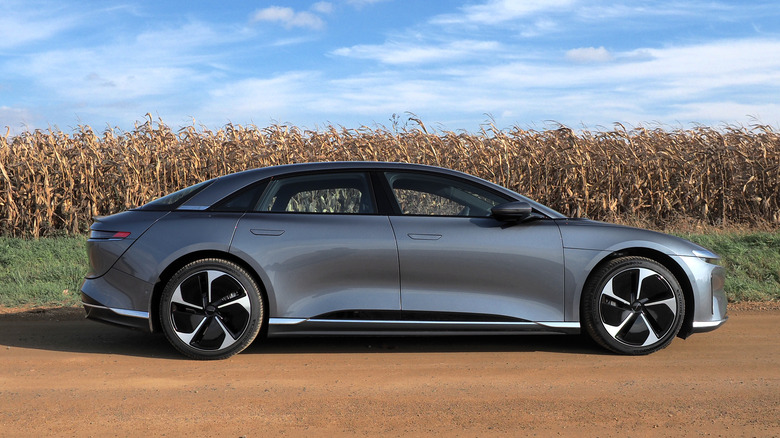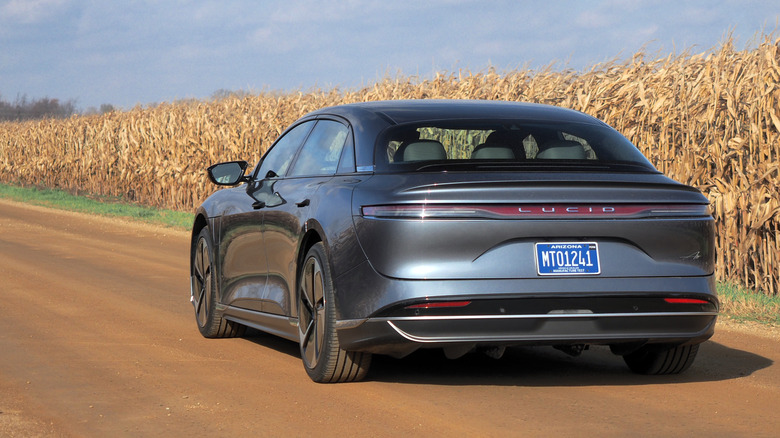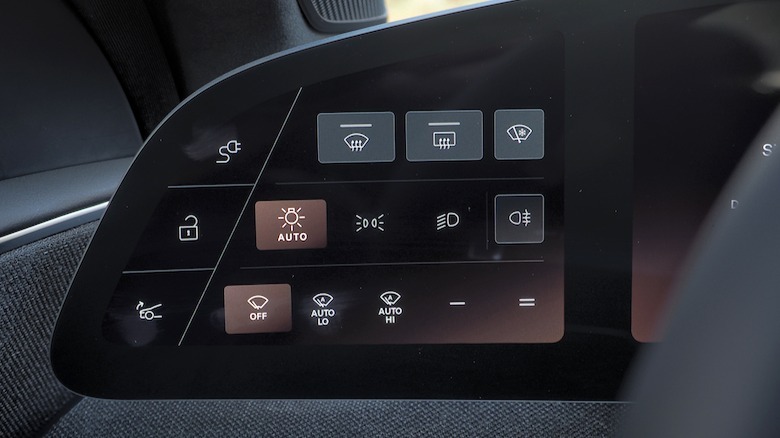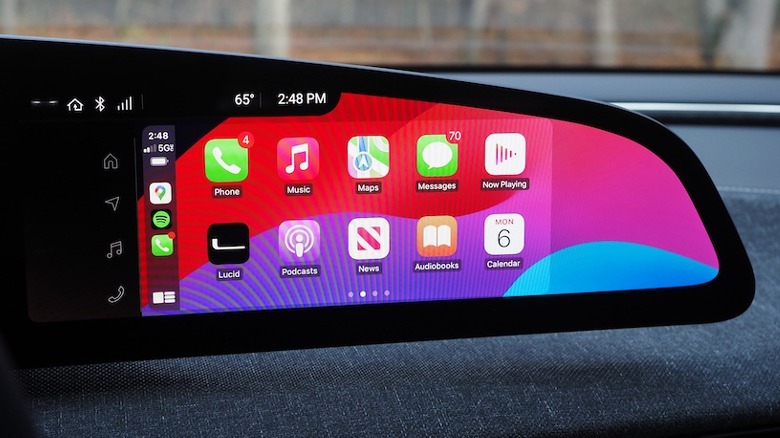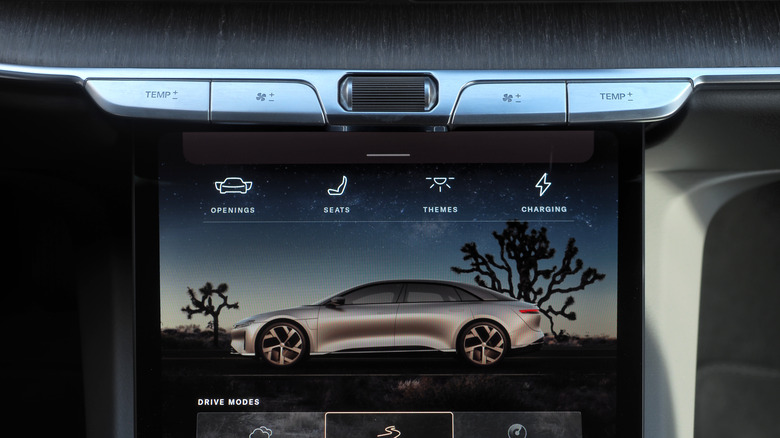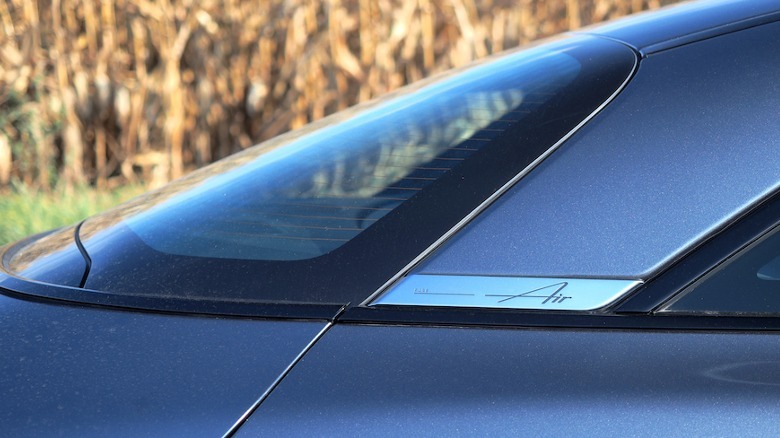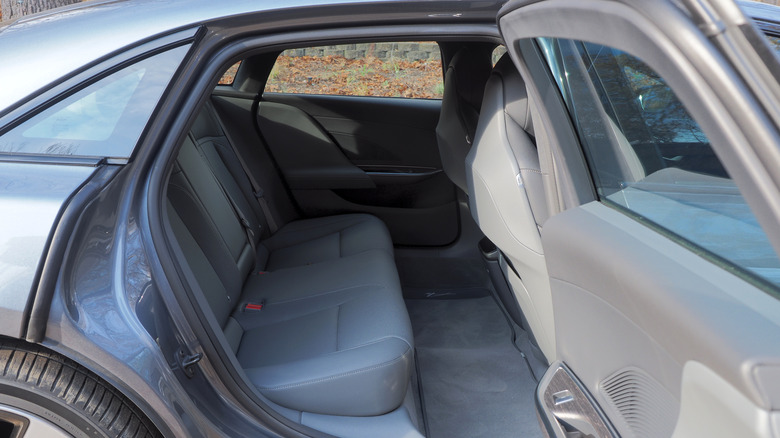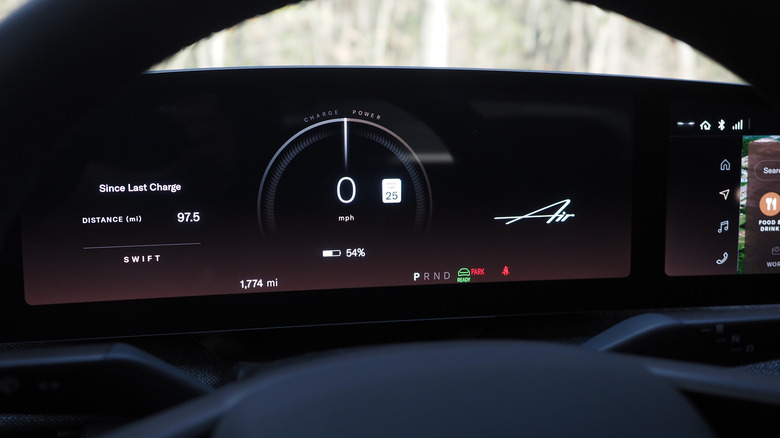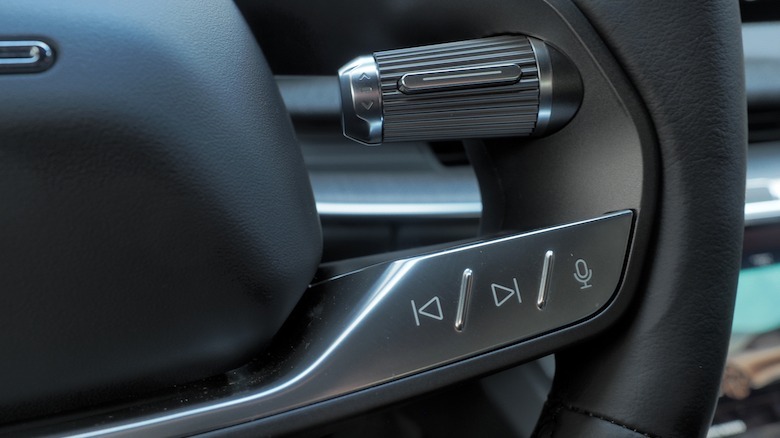2024 Lucid Air Pure RWD Review: More Than The Price Is Right
- Even with just one motor this is still a fast EV
- Impressive range potential
- Spacious cabin feels luxurious
- High level of standard equipment
- Still not cheap enough to sway the mass-market
- Touchscreen adjustment of mirrors and wheel is annoying
- Some digital gremlins remain
If electric cars are going to succeed, they can't solely be the preserve of the rich. Nobody is going to confuse the new Lucid Air Pure for a mass-market runabout, no, but with a price tag starting under $80k it's still the most affordable of Lucid Motors' EVs. The question is, has the automaker sacrificed what made the Air so appealing as it also chased greater attainability?
Though the automotive press may have billed Lucid as Tesla's biggest threat, it's fair to say the broader motoring public may not be so familiar with the American upstart. The upcoming Lucid Gravity SUV will hopefully help with that, along with a deal with Aston Martin to use Lucid's homegrown electric motor and other EV tech in future cars. For the moment, however, it's down to the Air to broadcast Lucid's talents, and there things remain far from the tipping point.
So, Lucid would probably prefer its name to be better-known, but that rarity still leaves the Air a head-turner. The fact that the EV looks like a spaceship on the road helps, drawing confused attention in a way that electric cars from Tesla and others haven't for years, now. Style may be subjective, but Lucid deserves kudos for managing to deliver impressive range estimates without resorting to making the Air an entirely amorphous blob.
Trickle-down electronics
Like most automakers launching electric cars — especially those kicking off a whole new brand — Lucid started out targeting the richest possible clientele. When production of the original Air Dream Edition began in late 2021, it carried a hefty $169,000 price tag. The Air Grand Touring that followed commands a $125,000+ sticker, or almost $150k if you want the more potent Performance version.
Motivating those big-ticket sales was the promise of supercar-besting power. The Air Grand Touring has 819 horsepower and a 0-60 mph time of just 3.0 seconds, with an EPA range of up to 516 miles on 19-inch wheels. Opting for the Performance trim nudges that up to a frankly ridiculous 1,050 horsepower, trims the 0-60 time to 2.6 seconds, and yet somehow also delivers 446 miles of EPA range.
The reality of the auto world is, however, that you can't just sell to the super-wealthy forever. Well, not if you want to be more than a boutique brand like Rolls-Royce or Bentley, and Lucid clearly has aspirations to dig into a more mass-market audience. That's where the Lucid Air Pure comes in.
Cuts where they count most
The Air Pure is — by Lucid standards, anyway — affordable. It starts at $77,400 (plus $1,575 destination) in rear-wheel drive form. The upgrade to all-wheel drive, which adds a second electric motor driving the front wheels, costs $5,000.
The former has 430 horsepower and a 4.5 second 0-60 mph time, along with an estimated 419 miles of EPA range on 19-inch wheels. Opting for AWD pushes total power to 480 hp and cuts the 0-60 time to 3.8 seconds, while the EPA range on the standard 19-inch wheels is 410 miles. Lucid offers the 20-inch Aero Lite wheels you see here as a $1,500 option, though that cuts the range further: to 394 miles on the RWD car or 384 miles on the AWD.
It's worth noting that these are still pretty wild figures, even if they're not the face-rearranging, state-spanning numbers of the Air Pure's more expensive brethren. A rear-wheel drive Mercedes-Benz EQE 350+ Sedan, for example, starts at $74,900 (plus destination) yet takes 6.2 seconds to do the 0-60 mph dash, and is only rated for 305 miles on a full charge.
The all-wheel drive Genesis Electrified G80 — which I rate highly — starts around $80k with destination, yet is down on power and has a third less range than the Air Pure AWD. You really need to look to Tesla and the Model S Dual Motor All-Wheel Drive from $74,900 (plus destination), for something comparable to Lucid's offering. That has 405 miles of range and a 3.1 second 0-60 mph time.
Fewer compromises than you might expect
Lucid has, unsurprisingly, trimmed some of the Air's niceties in order to hit the Pure's price tag. Beyond the cut in power and range, the most obvious is a switch h to a solid roof, replacing the expansive panoramic glass panel still offered on more expensive trims. As someone who invariably closes the sunshade on such roofs anyway — and having seen the ballpark replacement costs should a rogue rock shatter them — it's a compromise I actively welcome, frankly.
Faux leather is the other big swap, though the same genuine hide offered in the Air Touring trim and above is available as a $3,000 option. 20-inch wheels (or even larger) are standard on those pricier Air trims, too, though Lucid offers the 19-inch versions as a no-cost option for drivers wanting maximum range.
The only real omission that options can't get you on the Air Pure is DreamDrive Pro, the highest tier of Lucid's advanced driver assistance systems (ADAS). That includes (for $9,000 more on eligible cars) Highway Assist, blending adaptive cruise and lane-centering in a hands-on-wheel Level 2 system, and the promise — somewhat nebulous, like all such commitments across the industry — that one day the hardware suite you've paid so handsomely for will be capable of fully-autonomous driving.
A rocky start
Some cars you're more eager to drive than others, which made it extra frustrating when the Air simply wouldn't unlock for me on day one. A dead key fob battery was the culprit (it takes commonplace CR2032 button cells, but the promised on-screen warning of a low battery never apparently showed), though I couldn't get the backup NFC functionality — which should've unlocked the Lucid after pressing the door handle and swiping the fob on the driver's side B-pillar — to work. The NFC card the automaker also supplies was safely locked inside the cabin, and as this wasn't my Air, I couldn't register it to Lucid's smartphone app and do either remote unlock or set up the Bluetooth-based mobile key.
Lucid customer care can remotely unlock it (assuming the Air has data service for its baked-in modem) at which point it demands a PIN code to start it up. Still, the suggestion is to have at least two of the available methods on hand. For regular owners — rather than reviewers borrowing a pre-production car — this will probably never be an issue. Normally, the Air automatically unlocks and presents its fold-out door handles when you approach, and then locks itself when you walk away.
The same clean, comprehensive cabin
Like a lot of modern EVs, there's no ostensible power button: you simply sit down, buckle up, and — in the case of the Air — use the column-mounted shifter to switch into Drive. Lucid's cabin remains a supremely pleasant place to be, minimal without being obstructionist. There's a digital gauge cluster, expansive and yet uncluttered, with a small touchscreen to its left which handles things like lights, front and rear glass defrost, and wipers.
On the right, a larger, contoured touchscreen shows multimedia, navigation, and — thanks to a recent OTA software update — wireless Apple CarPlay, should you pair your iPhone.
Below is a far larger, portrait-aspect touchscreen that shows things like drive modes, vehicle settings, or a larger map view should you prefer it. Swiping up from the bottom of the screen sends it whirring back, revealing a large cubby.
There's more storage space in the center console between the front seats, along with a pair of snug cupholders and a wireless phone charger. I can see some owners being frustrated that the only way to open the shallow glove compartment is via an on-screen button, but I found the just-slightly-too-short indicator stalk more of an annoyance, along with the inability to show both the remaining battery percentage and range on-screen at once. You have to pick one or the other.
Balancing physical and digital
Still, Lucid doesn't do away with physical controls entirely, which is welcome. There's a volume wheel in the center of the dashboard, flanked by temperature and fan toggles, while the driver gets volume, multimedia, and cruise control buttons and knobs on the wheel. You'll need to use on-screen controls to adjust the steering wheel and side mirrors, mind, and there's no dedicated drive mode switch.
Instead, you flip between the Smooth, Swift, and Sprint modes with the larger of the two touchscreens. They're the same as in other Air models, tempering horsepower and torque among other factors, and you'll need to tap a "this is your EV at its most potent, are you sure?" confirmation button every time you switch into Sprint. That makes sense in a wildly powerful Air Sapphire, with 1,234 horsepower on tap, but feels like needless nannying in the Pure.
The reality is, even at its maximum setting, the Air Pure RWD doesn't have the same organ-rearranging fierceness we're familiar with from more potent EVs. It's fast, more than sufficiently so in fact, and the instantaneous torque delivery means darting through urban traffic and away from stop lights is still rapid enough to leave all but the most outlandish (and aggressively driven) gas cars way behind you.
Honestly, what Lucid is offering here will only feel like a compromise if you're used to driving a more powerful electric car. I suspect anyone segueing over from internal combustion will find the even reduced pace here wowing. The automaker's decision not to mess around with air suspension continues to demonstrate its worth, too: the sedan feels weighty and planted, but corners smooth and flat, without being so firm as to be uncomfortable.
Bigger on the inside
While flexible and spacious cabin design is often quoted as an advantage of electric vehicles, most don't take quite as much advantage of it as the Air. It's not just the fact that the interior feels as spacious as a vehicle from the size segment above, but the way the flat floor and excellent rear legroom emphasize just how, well, airy the Air is. In fact, those in the rear get even more space for their feet thanks to a smaller battery pack than other models.
As standard, the front seats are 12-way power-adjustable and heated; $3,750 upgrades them to 20-way adjustment and adds ventilation and massage. A $2,500 Comfort & Convenience Package throws in soft-close doors, heated rear seats and a heated steering wheel, four-zone climate control, and power rear and side sunshades. The standard audio system has nine speakers; spending $2,900 gets you a 21-speaker upgrade with Dolby Atmos support.
Do yourself a favor and skip the options
Were it my budget, I'd skip them all, and the DreamDrive Premium upgrade to Lucid's standard ADAS suite too. For $2,000, that adds a bird's eye view camera and blind spot display, which beams a camera feed of the adjacent lane into the driver's cluster when you indicate. Nice enough, but the Air Pure comes with blind spot warnings, front and rear cross-traffic protection, automatic emergency braking and forward collision warning, lane departure protection, rear pedestrian collision protection, and distracted/drowsy driver monitoring by default.
There are also park distance warnings — which actually count down the inches you have to spare — together with adaptive cruise control, and parking assistance for parallel and perpendicular spots. Lucid's trunk — which opens sedan-like, rather than a hatchback — presents a fairly low, wide space, though pull up the floor panel and there's an impressively deep compartment underneath.
Key weirdness aside, none of the software gremlins or foibles I'd seen on earlier Air builds appeared here. The infotainment system started up fast and had no issues reconnecting to wireless Apple CarPlay each time. With that fresh fob battery, the door handles never failed to present themselves as I approached, and nor did the Air ever forget to lock itself as I departed.
Be realistic about range
As for range, my urban-centric driving saw the Air Pure RWD hit 2.9 miles per kWh. I'll blame a heavy right foot and temperature conditions in the 40-50F region for that; other recent drives had seen 3.4 miles per kWh. That's still down on the 394-mile estimate Lucid promises from the Air Pure RWD on 20-inch wheels — and a reminder that weather has a sizable impact on EV range — though around what rivals like the EQE Sedan and Electrified G80 delivered.
When it comes to charging, the Air supports up to 19.2 kW on Level 2 chargers, though you'll need a (rare) model that supports up to 80A for that. Lucid's own Connected Home Charging Station is one such example, and will also — eventually — support bidirectional power to keep a house up and running during an outage from the EV's battery, assuming a) it's all installed correctly, and b) a promised OTA update from Lucid turns that all on. For now, there's freshly added support for charging another EV at up to 9.6 kW, though you'll need a $125 adapter for that first.
On the road, there's up to 300 kW DC fast charging support, and Air Pure buyers — as long as they act fast since the current deal expires before the end of 2023 — get a year's free sessions at Electrify America stations. Lucid has confirmed it'll be switching to the NACS charger plug in 2025, and Air drivers will get Tesla Supercharger access.
In ideal conditions, on a suitably potent charger, Lucid says you'll see around 200 miles of range added in 15 minutes. Temperature also plays a huge role there, however. With conditions in the low-40F region, I never got above 100 kW: sufficient for around 7 miles of range added per minute connected.
Lucid Air Pure RWD Verdict
It probably says something that, even though it locked me out on our very first day together, I still want a Lucid Air more than the Tesla, Mercedes, BMW, or Genesis alternative. It nestles near-perfectly at its intersection of quiet luxury, electric refinement, and occasional playfulness. It's clearly tech-savvy, but not overwhelmingly so, and it resists most opportunities to sacrifice practicality in the name of gimmicks.
Meanwhile, though I'm a sucker for an OTT EV, I feel like the Pure hits a sweet spot. Those in cold weather states will probably want the AWD option, but even then the price tag is competitive for the segment, and the performance is more than sufficient. Lucid doesn't even shame you for your frugality: the Pure's minimal rear pillar badging is the only real indicator you prioritized price over pace.
Clearly, this is still not the car to bring electrification to the masses. As broader adoption of EV tech goes, models like the upcoming 2025 Volvo EX30 will be pivotal, and regardless of price, there remain legitimate questions around things like electric vehicle incentives and charging infrastructure. An $80k+ luxury car won't move the needle there.
What it will — and should — move is Lucid's prominence. The biggest complaint I had about the Air before was that it was priced out of contention for most of those considering a high-end EV. The fact that this Air Pure addresses that, without compromising on the vast majority of what leaves more expensive variants feeling special, makes it an achievement better than many more established rivals have managed. Lucid still has plenty of work ahead to demonstrate it's more than a one-trick pony, but it could do much worse than treat the Air Pure as the blueprint for that expansion.


